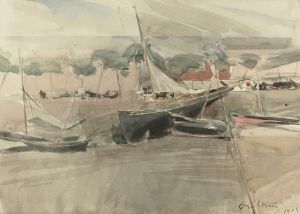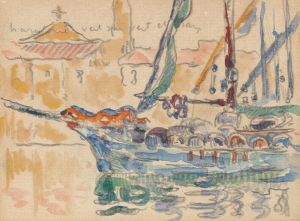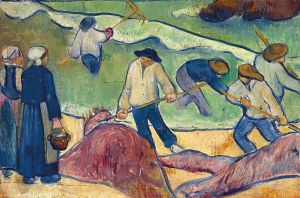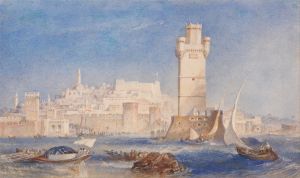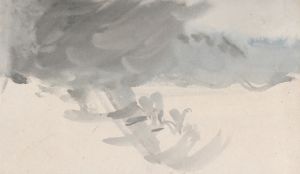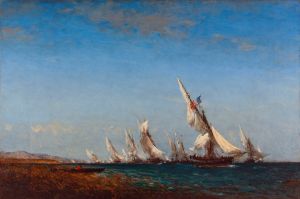
Line Fishing, Off Hastings
A hand-painted replica of Joseph Mallord William Turner’s masterpiece Line Fishing, Off Hastings, meticulously crafted by professional artists to capture the true essence of the original. Each piece is created with museum-quality canvas and rare mineral pigments, carefully painted by experienced artists with delicate brushstrokes and rich, layered colors to perfectly recreate the texture of the original artwork. Unlike machine-printed reproductions, this hand-painted version brings the painting to life, infused with the artist’s emotions and skill in every stroke. Whether for personal collection or home decoration, it instantly elevates the artistic atmosphere of any space.
"Line Fishing, Off Hastings" is a painting by the renowned British artist Joseph Mallord William Turner, often referred to simply as J.M.W. Turner. Turner, born in 1775, is celebrated for his innovative and expressive landscapes and seascapes, which have earned him a place as one of the most influential figures in the history of Western art.
This particular painting, "Line Fishing, Off Hastings," is a fine example of Turner's fascination with the sea and maritime subjects, a theme that recurs throughout his oeuvre. The painting captures a scene of fishermen engaged in line fishing off the coast of Hastings, a town located on the southeast coast of England. Hastings was a significant fishing port during Turner's time, and it provided a picturesque setting that inspired many artists.
Turner's work is known for its dramatic use of light and color, and "Line Fishing, Off Hastings" is no exception. The painting showcases Turner's ability to convey the atmosphere and mood of the sea, with its dynamic skies and the interplay of light on water. His technique often involved the use of loose brushwork and a vibrant palette, which helped to evoke the movement and energy of the natural world.
The painting reflects Turner's interest in the everyday lives of people who made their living from the sea. Line fishing, a method involving a fishing line with baited hooks, was a common practice among fishermen in the 19th century. By depicting this activity, Turner not only captures a moment in time but also highlights the relationship between humans and the natural environment.
Turner's work was revolutionary for its time, as he moved away from the detailed and precise style that characterized much of the landscape painting of the 18th century. Instead, he embraced a more atmospheric and emotive approach, which would later influence the Impressionists and other modern art movements. His ability to convey the sublime power of nature and the vulnerability of human endeavors within it is a hallmark of his work.
"Line Fishing, Off Hastings" is part of Turner's broader exploration of the sea as a subject. Throughout his career, Turner produced numerous paintings and sketches of maritime scenes, ranging from calm coastal views to tumultuous storms. His deep understanding of the sea's many moods and his ability to translate them onto canvas have made his seascapes some of the most admired in art history.
Turner's legacy is preserved in numerous collections around the world, with many of his works housed in prestigious institutions such as the Tate Britain in London. His influence extends beyond his lifetime, as he paved the way for future generations of artists to explore new techniques and perspectives in landscape painting.
In summary, "Line Fishing, Off Hastings" exemplifies J.M.W. Turner's mastery of capturing the essence of the sea and the lives intertwined with it. Through his innovative use of light and color, Turner not only depicted a specific moment in history but also contributed to the evolution of landscape painting as an expressive and dynamic art form.





